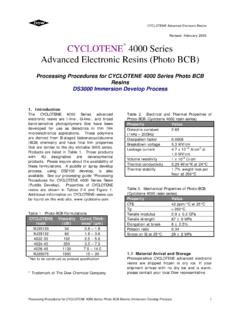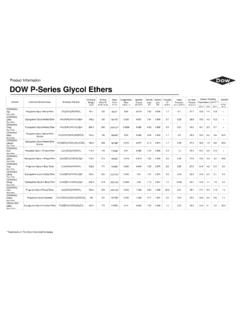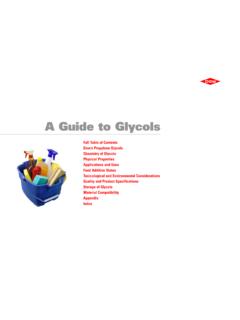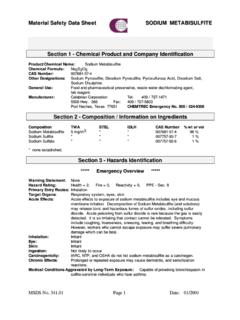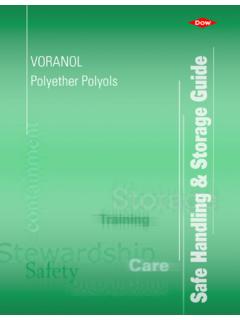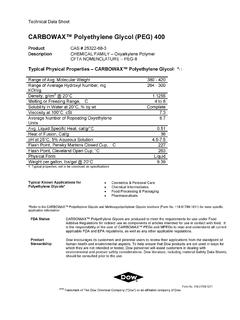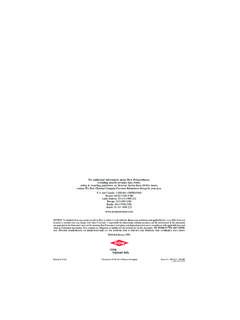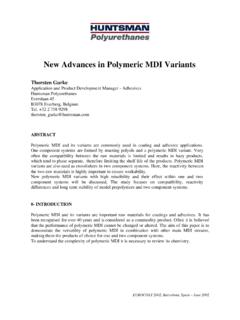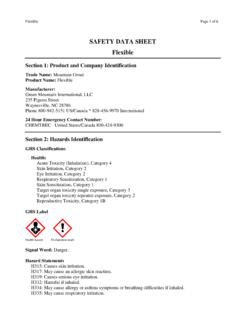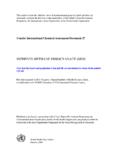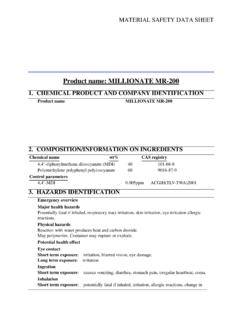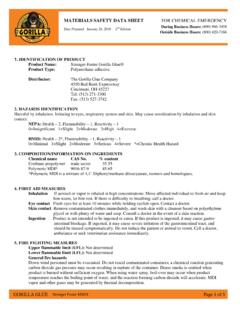Transcription of PAPI 135 - Dow eLibrary
1 papi 135 Polymeric MDIP roduct InformationPAPI 135 POLYMERIC MDIPAPI* 135 polymeric MDI is apolymethylene polyphenylisocyanatethat contains MDI. This product has ahigh reactivity, due to a high diphenylmethane diisocyanate is ideally suited to a wide vaiety ofapplications where demolding andprocessing times must be kept at a minimum, such as appliancefoams, spray insulation, andcontinuous : To maintain product qualityand easy handling, this product mustbe stored between 75 to 105 F (24 to 41 C). Shipping and storagetemperatures vary with conditions;see Storage Appliance foams Portable coolers Automotive interior foams Furniture Building panels Spray insulation Structural foams Refrigerated truck insulation Elastomers, adhesives, coatings and sealantsTYPICAL PROPERTIESP ropertiesTypical Value1 Average molecular weight340 Functionality equivalent weight3 content by weight, %3 , cps @ 25 C3(77 F)150-220 Typical viscosity growth, cps/mo.
2 @ 25 C4(77 F)5-10 Vapor pressure, mm Hg @ 25 C (77 F)<10-5 Decomposition point C ( F)230 (446)Extrapolated boiling point, C ( F)330 (626)Flash point, C, ASTM D 93 Closed Cup ( F)>204 (>400)Acidity, % as HCl3 , g/ml @ 25 C (lb/gal. @ 77 F) ( )Coefficient of thermal expansion, kg/l/1 heat, gm cal/gm conductivity, gm cal/cm sec C to be construed as true functionality, but typifies expected cross-link densities in end use test procedures, see Technical Bulletin 109-761, PAPI Polymeric MDI, Test Procedures. 4 Under recommended handling Plastics, a business group of The Dow Chemical Company and its subsidiaries.*Trademark of The Dow Chemical CompanyPage 1 of 4 Published 3/01 LOES No. 026-00010 Form No.
3 PA-26-360-03010255075100125 Temperature, C1000100101 Viscosity, cps010203040 50 60 70 80 90 100 120 140 Temperature, Pressure, mm HgViscosity vs. TemperatureVapor Pressure vs. TemperaturePAPI 135 Polymeric MDIPage 2 of 4 LOES No. 026-00010 Form No. PA-26-360-0301 SAFETY CONSIDERATIONSPAPI polymeric MDI products arepotentially hazardous materials andrequire care in handling. All personswho work with these materials mustknow and follow proper safe Material Safety DataSheets (MSDS) and additionalinformation about the safe handling,storage and use of these materialsare available through your Dowrepresentative.
4 Dow MSDS may beobtained from head office ofDow Chemical Pacific Limited bycalling (852) 2879-7333. Pleaserequest and review the informationbefore handling these PRECAUTIONSF irst AidPolymeric MDI is irritating to therespiratory tract and can causerespiratory and skin sensitization insusceptible individuals. Althoughvapor pressure is low, there is thepossibility that the polymeric MDI mayexist in aerosol droplets which mayprovide air concentrations that wouldbe hazardous upon single effects may be ventilatory capacity hasbeen associated with exposure tosimilar isocyanates; it is possible thatexposure to MDI may cause similarimpairment of lung function. In caseof inhalation exposure, remove tofresh air. Consult medical MDI may cause eye andskin irritation. Because of its highviscosity, this material may be difficultto remove from the eyes.
5 In case ofeye contact, irrigate immediately andcontinuously with water for at least 15minutes. Consult medical case of skin contact, wash offmaterial in flowing water or contaminated clothingimmediately and launder beforereuse. Destroy contaminated shoesand leather items. The single dose toxicities ofpolymeric MDI is low. If ingested, donot induce vomiting. Consult should wear appropriate eyeprotection (safety glasses areconsidered a minimum requirementand if there is the possibility ofexposure to the eyes, it isrecommended that chemical gogglesbe worn) and protective clothingimpervious to MDI whenever MDI isused. General or local exhaustventilation should be provided tocontrol airborne levels below theexposure guidelines. Please reviewthe MSDS for this vapor pressure of MDI is lowat room temperature (<1 X 10-5mmHg).
6 However, at temperatures over104 F (40 C), the vapor pressureincreases enough that lowfunctionality MDI products begin toconstitute a toxic hazard. Aerosolmists can also be a of pure and polymeric MDImust be protected from moisturecontamination. Exothermic generationof CO2may cause dangerouspressure build-up if contaminationoccurs. Store drum under a pad of -40 F(-40 C) dew point nitrogen or ifnitrogen is unavailable, a pad of-40 F (-40 C) dew point air may beused. Opened containers should befilled with this inert atmosphere beforeclosing. During drum unloading, the3/4 vent may be equipped with a dryinert gas breather (maximum of 1 psigpressure) or a moisture free, calciumchloride-filled dryer tube placed in theair bleed and storagetemperatures for this product are75 to 105 F (24 to 41 C).
7 If shipping or storage temperatureshould fall below 65 F (18 C), somecrystallization could result. Unlessproper action is taken to re-form theoriginal solution, subsequentdimerization will proceed quickly andwill deteriorate the assay of theproduct. Melting InstructionsIf drum shipments of polymeric ormodified MDI products arrive in acrystallized, frozen or fused state,they should be promptly unloadedand heated as soon as , pure and modified MDIproducts that have been frozen willexhibit the same dimerizationcharacteristics as pure MDI. Unlessproper action is taken to heat or meltthe product, dimerization will proceedrapidly and deteriorate both the clarityand assay of the product. While several methods for meltingfrozen or crystallized MDI have beendeveloped, the method of choiceshould be one in which dimerformation is minimized.
8 This can bestbe accomplished by rapid, evenheating of the drums, as follows. The preferred method for heatingdrums is drum rolling (usually at 5rpm on a mechanical drum roller) inatmospheric steam. The principaladvantage of this method is that itpermits efficient heat transfer - that is,the solid MDI crystals cool theliquefied material so that the contentsare not heated much beyond 70 C(158 F), the point at which dimerformation can increase significantly. Experience has shown that afrozen drum of polymeric, pure andmodified MDI, with a temperaturebetween -4 to 32 F (-20 to 0 C) willusually melt completely ( , reach70 C [158 F] in approximately four tofive hours). Also, while 70 C (158 F)is significantly higher than therecommended storage and handlingtemperature, it is necessary to reachthis temperature, at least briefly, inorder to melt the product both quicklyand heating, any opened drumsshould be reblanketed with drynitrogen (-40 F [-40 C] dew point)and all drums, previously opened ornot, should have bungs 3 of 4 LOES No.
9 026-00010 Form No. PA-26-360-0301 FOR MORE INFORMATIONFor additional information about MDIproducts, consult the Safe Handlingand Storage of MDI-BasedIsocyanates handbook (Form ) from Dow or contact Dow Chemical Pacific Limited at(852) 2879-7333 (Hong-Kong).Also, review the current MSDS forthis NoticeDow encourages its customers toreview their applications of Dowproducts from the standpoint ofhuman health and environmentalquality. To help ensure that Dowproducts are not used in ways forwhich they were not intended ortested, Dow personnel are willing toassist in dealing with ecological andproduct safety considerations. YourDow representative can arrangeproper be equipped with protectiveclothing and a positive pressure, self-contained breathing of isocyanate involved in a fireshould be sprayed with water tominimize the risk of rupture.
10 However,water contamination in a closedcontainer or a confined area is to beavoided, due to exothermic CO2evolution upon water and DisposalIn case of spills, evacuate andventilate the spill area. Only properlytrained and protected personnelshould be involved in the spill cleanupand waste disposal operations. Spillscan be covered with a commercialabsorbent or sand, shoveled intoopen containers, properly labeled andremoved from the work area fordecontamination with a solution of 95percent water, 5 percent ammoniumhydroxide. Waste disposal ofisocyanates should always be inaccordance with federal, state andlocal environmental laws removal from the steamchest, residual heat will usuallyevaporate free water from the drumhead. In any event, the top of the drumshould be wiped with a dry can be seen, agitation and evenheating is the key to maintainingquality during melting.
